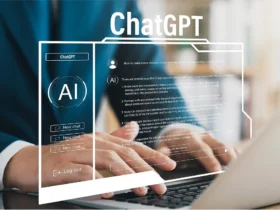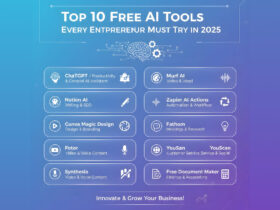In the US, the growth of generative AI is impressive, and it’s already impacting business practices. With this advanced software, users can design new text, pictures, patterns, and programs. It works differently from traditional AI, which primarily focuses on sorting or processing data.
GenAI does even more by creating and building, allowing teams to complete tasks more efficiently and effectively. AI is increasingly used in marketing, customer service, and product development across various areas.
For those in professional fields, finance or government in the US, Generative AI is now something they must learn about. Technology creates exciting opportunities, but also raises questions about important things. What will happen to the current job market? Which guidelines ensure it is handled without harm or unfairness? How can companies help their people adjust to these significant changes?
This article looks at the main trends, threats, and opportunities that come with GenAI in the US. You will learn about recent advancements, where various industries are applying them, where the economy is headed, and what obstacles should be noted. You will learn many valuable strategies to help you prepare, compete and lead in the changing world of business.
Understanding Generative AI in the US Context
Generative AI is an area of artificial intelligence that can generate new content, such as writing, creating art, designing objects, or composing music. This is distinct from AI that came before, which typically processed or reviewed information. It studies a broad range of data and produces content similar to what people might write based on their experience.
This innovation was built up step by step. For years, the field has expanded because of the efforts of researchers and technology companies, primarily in the United States. Developing GenAI models like GPT, Bard, and Claude was made possible in part by OpenAI, Google, and Stanford. More and more US businesses are using these tools, and they are becoming increasingly simpler for people to work with every day.
Generative AI is being rapidly developed and used in the US. It has developed strong tech firms, drawn considerable sums from venture capital, and cultivates a mindset of trying new things. GenAI is utilised in various US industries, including healthcare, finance, education, and media, to help individuals become more efficient. Yet, the country must address several significant issues, such as managing state and federal laws, protecting people’s data, and ensuring AI is fair. Therefore, understanding how GenAI is evolving in the US and what distinguishes its market is crucial. For more insights into top AI tools and concepts, explore our DeepMind Review, Midjourney vs. DALL·E comparison, and AI Terms Explained.
Key Generative AI Trends Shaping the US Market
Smarter and Larger AI Models
Large and modern AI models, including GPT-4, Claude, and Bard, are a significant trend in the US today. With these tools, you can do complex work and develop emails, reports, and code with accurate results. At the same time, businesses are striving to make these models work more efficiently and require less computing power, thereby making them more affordable and accessible to everyone.
Multimodal AI Capabilities
AI now helps us by tackling various domains, not only text-based ones. They can also handle images, audio, and video simultaneously. In some cases, AI is used to assist designers by analysing both product sketches and customer comments. As a result, AI is useful in both creative and visual professions.
Easy Access for Non-Tech Users
Using generative AI is getting simpler for more people in their day-to-day work. Now, business professionals such as marketers, teachers, or sales teams can take advantage of AI, thanks to clear user interfaces and APIs. Companies in the US can now apply AI in various parts of their business without requiring a large IT staff.
AI Tailored to Specific Industries
Rather than using regular AI, US companies are switching to GenAI solutions that are tailored to their specific industries. These systems are created by collecting and utilising information from a specific sector, such as healthcare, law, or finance. Their understanding of the unique terms and rules in every industry enables them to provide more accurate and helpful advice. It is particularly beneficial in the US, where different parts of the industry are governed by diverse regulations and cater to various customer needs.
Rise of Autonomous AI Agents
AI systems, known as agents, are becoming increasingly popular because they can perform tasks with minimal instruction. Such agents are capable of replying to customer messages, organising records, and handling order management independently. Many businesses in the US are analysing the ways that these tools can enhance automation and help save time, expense and raise productivity.
Economic Impact and Market Size in the US
Generative AI is more than a trend — it is quickly growing as a central aspect of the US economy. It examines the current size of the GenAI market, predicts its growth rate, and highlights the areas that attract significant investments. The importance of AI to America’s economy can be understood by studying these statistics. It also reveals the vast possibilities and intense competition for both businesses and investors.
Current Market Size and Growth
Generative AI has already made a significant impact on the US economy. Today, the GenAI market in the United States is worth hundreds of billions of dollars, as people utilise software, cloud services, and AI for various purposes. GenAI is helping US companies handle duties more quickly, reduce costs and remain competitive. Due to this strong demand, the market has been growing rapidly over the years.
Future Projections and GDP Impact
It is expected that the GenAI market in the US will increase by at least 30% year over year for approximately half a decade. By 2030, these changes could result in trillions of dollars for the US through increased productivity and the creation of new types of work. Artificial intelligence enables people to work more efficiently and facilitates the creation of new business processes. If invested appropriately, this growth could increase the country’s GDP.
Venture Capital and Startup Investments
Investment in GenAI is also growing in the US. In 2023, VC firms invested substantial amounts of money in companies focused on GenAI. Most attention is given to AI software platforms, custom model builders, and industry-focused applications. GenAI has become a key focus for major tech companies, as evidenced by their acquisitions of small GenAI startups. This continued flow of funds is allowing the US to maintain its lead in AI.
Industry-Specific Impacts in the US
Generative AI is being applied differently across various industries in the US. AI is assisting companies across multiple sectors by addressing challenges and opening up new opportunities. In this section, we present practical examples of AI transforming specific industries and examine the implications for businesses in the US. They illustrate that GenAI makes processes faster and more creative, but it needs careful planning to work well.
Healthcare
In America, doctors and hospitals rely on Generative AI to expedite the availability of drugs, aid in diagnoses, and manage both medical records and billing documents. Companies like Nvidia and IBM Watson Health are utilising AI to review large datasets of medical information much more efficiently than humans can. As a result, doctors can make more informed choices and help patients receive treatment more quickly.
Finance
GenAI is assisting banks and investment firms in identifying fraud, building financial statements, and offering tailored advice to each individual. AI is helping JPMorgan Chase and other US firms review contracts and identify market risks. They make decisions faster, more correctly, and save time for financial teams.
Education
In the US, GenAI is utilised by both schools and learning sites to create custom lessons for students and assist teachers in developing and sharing content. Khan Academy is among those utilising GPT-4-based AI to provide students with guidance tailored to their study habits. GenAI helps teachers create quizzes and efficiently answer student questions.
Entertainment and Media
GenAI is playing a role in this industry by helping to form screenplays, generate music and make digital art. Streaming services and ad agencies use these tools to execute tests with new ideas and create what customers perceive as more personalised content. Yet, deepfakes and copyright protection are also essential subjects in the US legal system.
Manufacturing
The US manufacturing industry relies on GenAI to build products, conduct predictive maintenance, and control its supply chain. For instance, General Electric uses AI to predict machine failures, allowing them to address them before they occur. As a result, production slows down less, and efficiency is improved on the production line.
Legal Industry
GenAI is helping law firms in the US review documents, provide case summaries and create contracts. Harvey AI, designed for use by lawyers, enhances research and automates routine tasks. Despite their usefulness, lawyers must always check the results to prevent any errors.
Retail and E-commerce
In the US, retailers rely on GenAI for the content of product descriptions, personalised advertising, and chatbots that help with customer service. With these tools, brands like Walmart and Amazon can enhance the shopping experience and meet customer expectations. With AI, they can give product recommendations, provide information, and streamline the support process.
Challenges and Problems Shaping the US Landscape
Generative AI is beneficial, but it also raises issues related to its use, particularly in the US. Companies and policymakers are encouraged to address the main concerns about law, jobs, bias, and privacy to ensure AI is used safely and justly. Solving these problems will help keep the public’s trust and promote the ongoing growth of AI.
Unclear and Evolving Regulations
There are no set, clear rules governing the use of Generative AI in the US. Each state develops its laws, although the federal government is working to form national policies. One of the primary concerns is ensuring data privacy, copyright protection, and assigning responsibility if AI causes harm to individuals. Although the White House and NIST have introduced new guidelines, many companies find it challenging to manage the rapidly changing rules.
Impact on the Job Market
Many people in the US are concerned that GenAI could replace them in their jobs. Although AI handles routine work, it also leads to the creation of new jobs that are different. Getting people ready for these changes is the hardest part of the process. For this reason, companies and governments should invest in retraining and developing skills for individuals in jobs that are at risk. Planning for a future workforce — often referred to as “Workforce 2030” — is now more crucial than ever.
Bias, Fairness, and Ethics
Sometimes, there is a risk of bias or unfairness from a Generative AI system due to past discrimination in the training process. This is a significant issue in the US for tasks such as hiring employees, deciding on loans, and addressing criminal matters. Another problem is that many AI systems are complex to understand because their decisions cannot be easily explained. Businesses must become more responsible by utilising technology to detect bias and developing trustworthy tools.
Data Privacy and Security Risks
GenAI functions well if it has a large amount of data, and some of this data may be personal or sensitive in nature. In the US, there is CCPA protection for users, though further regulations are needed on a national scale. Leaks of personal information and hacking pose significant risks that compromise trust and may lead to lawsuits. Improving how businesses manage their data and securing their AI systems is necessary.
Too Much Hype, Not Enough Reality
GenAI could be beneficial, but there is also a risk in overhyping its promises. While some businesses seek instant results and significant savings, most AI projects require patience, thorough preparation, and a well-defined budget. People may feel disappointed if AI doesn’t live up to its potential. US companies should set achievable goals and focus on what matters in the long run, rather than chasing fleeting excitement.
Complex Integration into Existing Systems
Integrating GenAI into complicated business systems in the United States is a big challenge. It can be challenging to integrate AI with systems that have been in use for a long time. Some businesses lack both the necessary expertise and suitable infrastructure to utilise these tools effectively. A well-planned approach and the essential support can help an AI tool perform better than it would on its own. Because of this, experts advise starting with simple trials and expanding gradually.
Potential Solutions and Strategies for the US
There are simple actions that US businesses and leaders can take to deal with AI obstacles and maximise its use. Here, we examine strategies for making regulations brilliant, training staff, utilising AI ethically, and related issues. It brings together principles for AI development that will benefit Americans and their communities. Using these methods guarantees a fair and safe use of AI by everyone.
Build Smarter, Balanced Regulations
For safer innovations, the US requires fairness in laws that encourage innovation yet protect people. Policymakers should involve tech companies, experts, and the community in making smart rules. By following the NIST AI Framework and receiving support from the government, the US can improve its guidelines and advance AI research. Such collaboration can result in fairer, more ethical, and stronger laws in artificial intelligence.
Help Workers Learn New Skills
Since GenAI is redefining job roles, it is necessary to improve and change the skills of the US workforce. For this reason, it’s essential to train employees in areas such as AI tools, data usage and management, and digital thinking. Businesses should provide learning opportunities, and schools should adapt their instruction to match the skills required for future jobs. Raising AI literacy among all team members helps them adapt and maintain their value within the company.
Create Clear Ethics and AI Guidelines
US enterprises should establish ethical guidelines for the use of GenAI. For this reason, tools must check for bias, decisions need to be clear to everyone, and systems should feel secure to use. Clear rules prevent incorrect activities and demonstrate to customers and employees that the company takes AI seriously.
Protect Data and Strengthen Security
The safe use of AI requires effective data governance. Firms should secure their data, adhere to privacy laws, and utilise robust security systems to safeguard their AI systems against threats. If you start with a proper data plan, you can safely introduce GenAI to different parts of your organisation.
Start Small and Integrate Slowly
It is better for companies to first work on small GenAI pilot projects rather than trying to fix everything at once. Workers in AI can help by updating email systems for support or producing content for the team. After that, they can grow into other industries. GenAI should be integrated into your broader strategy, not used only when time is limited, and it should work smoothly with existing systems and teams.
Work Together and Use Open-Source Tools
Another way for US companies to make more effective use of AI is by collaborating with startups, research labs, and industry organisations. You can save money and have more freedom when using open-source AI models for experiments. Through these partnerships, organisations can refresh their knowledge, collaborate, and create enhancements to AI solutions more quickly.
Conclusion and Future Outlook
Businesses in the US are already adapting to Generative AI, which will have an even greater influence in the future. We examined what is propelling this change, from artificial intelligence to special business models and the growth of automated tasks. We’ve also discussed the economic benefits, job market shifts, and unique problems the US must address, such as adhering to regulations and maintaining ethical standards.
Over the next few years, American companies are expected to depend on GenAI for creating, innovating, and competing. Within the next few years, AI is expected to become significantly more potent in various sectors, including medicine, education, the legal field, business, and many others. In addition, introducing new rules, better instruments, and more knowledgeable workers will support a safer and more balanced future.
It is now essential for leaders, investors, and policymakers to act. Regardless of whether you’re using GenAI in your plan or managing its risks, always stay informed and involved. The future of GenAI in the US will depend on smart decisions made today — decisions that balance innovation with responsibility, and progress with purpose.


















Leave a Reply